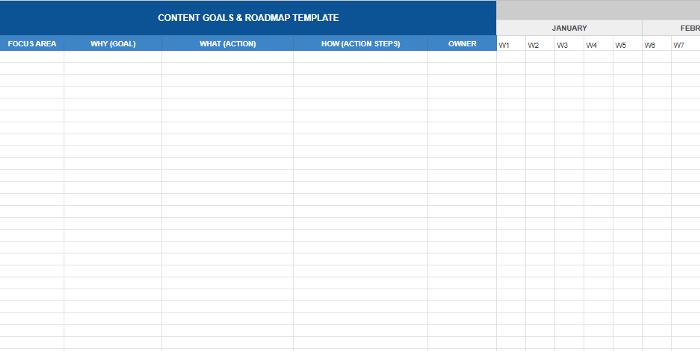Written on 15th February, 2022 | 5 min read
How to Develop a Content Roadmap That Supports Your Goals
Set content goals that align with your business and marketing objectives
Andreea Macoveiciuc
Strategist @School of Content

In small and medium-sized companies, where content marketing activities fall under the responsibility of a single person, content creation tends to happen in a more structured way. There’s usually a content calendar in place, and depending on the marketer’s experience, a content marketing strategy may also be documented.
However, when the size of the company grows and the number of stakeholders increases, content creation on an ad hoc basis tends to become the norm. Not because the content marketer suddenly loses his organizing skills, but because stakeholders tend to care more about their interests than about the already existing plan.
How can you prevent the content chaos and keep your focus and sense of purpose, while satisfying your stakeholders’ expectations? By developing a yearly content roadmap that’s aligned to the general business objectives.
Defining the content roadmap: choosing the areas to focus on
If you’re already familiar with the (thinking behind this) process and you just need a template to fill in, feel free to skip the reading and use the files below:

Image: content roadmap template
Typically, if you’re defining the content roadmap for a new project or a new company, you’ll want to start by getting familiar with what’s already there. This means looking at the numbers and performing a content audit and inventory, to get a feeling of how the existing content performs.
I’ve detailed the process in this article: How to Do a Content Audit and Extract Actionable Insights
The content audit will give you insights into the quality of the content and will tell you which type of content works best for every target segment and goal.
The content inventory will help you discover all the content owned by your company and can serve as a basis for a gap analysis, content curation plan, or migration strategy.
Although tedious, the content inventory can also guide you in choosing — or not — a DAM system. You can narrow down the scope of the audit to the marketing content, or you can extend it to all the content owned by your company.
Once you know what content you have and how it’s performing, you can choose to focus on one or more of the topics below.
Fixing the basics
If the infrastructure is poor and the content lifecycle management is a nightmare, this is a good roadmap item.
Typically, you’ll want to make sure that your CMS is easy to use by content creators, that it reinforces governance through workflows and authoring roles, and that it has the right integrations in place for making omnichannel distribution possible.
Defining your target segments
Ideally, you’ll have this in place before starting to publish content, but it’s rarely the case. I’m not a fan of personas, but you should have a good understanding of who you’re talking to, what their typical needs and complaints are, and how your offer satisfies their needs while canceling the complaints.
This focus area can be split into multiple goals, such as conducting customer interviews, segmenting your customer database, gathering input from sales calls, etc.
Optimizing the existing content
I’ve detailed this topic in a separate article, so I won’t dive into it. You can read it here: The Process I Use When Optimizing New vs. Existing Content
A different approach for optimization is to start not from the goal (traffic/conversions), but from the current performance of the content (high traffic, low conversions vs. low traffic, high search potential).
Content conversions
This can mean increasing the newsletter subscriber list, generating leads for solutions or services with gated content, acquiring user-generated content.
Typical goals for this focus area include mapping the content to the marketing funnel or developing a content sequence or campaign that supports a conversion goal.
Traffic generation
You can focus on building backlinks, improving your content distribution, research, and ideation for finding the most relevant queries and keywords for your target segments and goals, on-page optimization. Filling in your content calendar can be an action point here.
Service/product conversions
Typically, you’ll want to target the marketing qualified leads, so a goal could be collecting FAQs and using them as a basis for lead generation pages, A/B testing product, or demo pages.
Improving the efficiency of your processes
Think of content reuse, localization processes, review and approval flows, content curation. On the technical side, you can also focus on improving the findability of your content by developing a taxonomy and metadata strategy.
Testing new content formats and distribution channels
This focus area is useful when you don’t know your audience well enough and you don’t have attribution models to indicate the best performing channels.
Customer retention / engagement / loyalty
Although these require more than content marketing, you can support a retention or loyalty strategy with content. Goals can include setting up automation flows for various scenarios and customer lifecycle stages.
Content curation
I’ve mentioned this one before, but I’ll list it as a separate focus area also, mainly because curating supplier/vendor content can be an excellent solution for small content teams looking to publish more consistently.
Measuring and reporting
As action points or goals, you can include setting up tracking, defining targets, creating dashboards and a process for reporting, defining your content CAC and ROI, and so on.
If you need help in seting content KPIs that support your business and marketing goals, get in touch with our team. We'll audit your content, analyze your data and set KPIs that will keep your team focused on the right thing.
Governance, roles, and responsibilities
Although technically this can be part of the process improvement goal, it’s wiser to keep it separated, as it can be a time-consuming process and can lead to friction in the teams. But having a clear governance model in place, with workflows, roles, and responsibilities is essential for avoiding siloed content creation.
I’ve detailed this topic in a separate article: Content Governance Model for Global Marketing Teams
Content personalization
If you have segments clearly defined and you’re collecting user data in an organized manner, you can start thinking about structuring your content and preparing your CMS for content personalization.
Actions steps here could be defining the content models, templates, and components you’ll be using, or building data models for predicting the user content consumption interests/patterns.
About content modeling, I wrote in a separate article: Content Personalization Prerequisites: The Content Model
Brand awareness
I’ve placed this one at the end, as you’re very likely to hear from your stakeholders that they just want content for traffic and awareness.
While brand awareness can definitely be the consequence of a well-implemented content strategy and marketing plan, I wouldn’t recommend making this your main focus area.
If you want to take that direction, make sure you narrow down your initial scope and focus on a specific segment, a specific pain point, and a specific solution. Don’t embrace the “everything for everyone” approach, it’s good just to keep you busy.